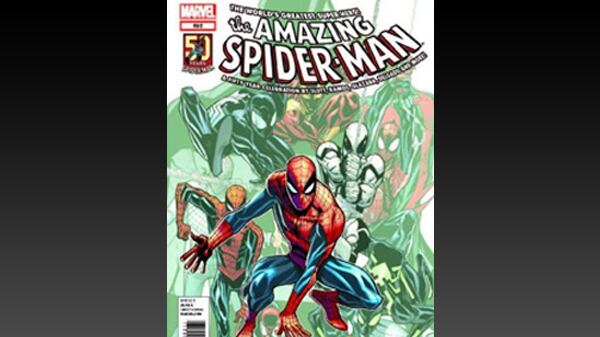In The Amazing Spider-Man #692, the 50th-anniversary issue of the adventures of Peter Parker, the now 30-something scientist attempts to impress a bunch of high-school kids. He’s talking up this physics experiment, and then, KABOOM, the thing explodes. A boy named Andy Maguire is zapped with high-energy “Parker Particles,” and a new hero is born—Alpha. Spider-Man has a sidekick.
Fifty years earlier, Peter—then a high-school kid from Forest Hills, Queens—was bitten by a radioactive spider. Talk about the arrival of the ’60s youth revolution: here was a teen crime-fighter who wasn’t a sidekick. It was a fresh spin on the age-old comic-book story.
Superheroes have become pop mythology for American culture, and Spider-Man has become the comic-book spokesman for youths feeling inadequate. Batman’s a psychopathic billionaire and Superman’s an alien Boy Scout, and they’re both older. But Stan Lee’s creation dealt with the adolescent problems of an ordinary high-school teen who begins growing hair everywhere on his body, can shoot off sticky white webby stuff, and prefers to wear a mask.
ADVERTISEMENT
Peter was a nerdy loner who was nervous around girls and hid his insecurities not only with a real mask, but also by cracking jokes. For angst-ridden and self-centered boys who often feel as though the cosmos align just to make their lives suck, it was an easy sell. The campaign slogan for Spider-Man, “With great power comes great responsibility,” is heavy, but also what moms tell their kids about taking out the trash.
Spider-Man has always been young. The core myth of a teen geek with superhuman abilities, learning to sacrifice for the greater good while wearing the best costume in comics, has endured. He’s been amazing, spectacular, astonishing, sensational, and whatever other superlative you tack on. But he’s never really been middle age.
Now he is. Spidey might not have a unitard-stretching gut or arthritic knees, but he hit the half-century mark this month. And in Marvel Comics’ anniversary issue, he gets a sidekick. Can we still enjoy Peter’s coming-of-age struggles with responsibility when we know he’s been through it for decades? The webhead may finally have met his ultimate foe: age.

With 692 issues and counting, The Amazing Spider-Man series is the hero’s main universe, or where stuff “really happens.” In the ’60s, Peter dealt with the death of his Uncle Ben and fighting bad guys while balancing school, work, and relationships. In 1973’s The Night Gwen Stacy Died, Peter’s girlfriend is thrown off a bridge and breaks her neck because of the whiplash caused by his web catching her. In the ’80s, he donned a black alien suit that sent him on a Breaking Bad-esque kick. (This was, we must remember, despite the forgettable movie Spider-Man 3, more than just an emo haircut and Devo dance moves.) In the ’90s Peter married his longtime love interest Mary Jane.
And in 2006 Peter unmasked himself on television as part of the Superhero Registration Act, where the government forced anyone with superpowers to register as a weapon of mass destruction and reveal their secret identity.
In the last few years, other separate, parallel series have sprung up. In 2007’s four-issue Spider-Man Reign, a 60-year-old Peter ditches retirement for a return to the suit. In 2010 he was even killed. But, once dead, a black and Latino middle-school kid named Miles Morales promptly picks up the mantle.
Meanwhile, the official The Amazing Spider-Man series encounters similar points of exhaustion. After Peter’s big TV moment, his aunt is killed, but to save her life Peter “sells” his marriage to Mary Jane to a demon, who also erases the world’s collective memory of Spider-Man’s identity—a “by the way, none of that happened,” a big “just kidding!” Fans were furious.
So here we are, at the milestone issue, with Peter a 30-something scientist who might or might not be dating Mary Jane still. While the debut of Peter’s sidekick mirrors Spider-Man’s own origin story, the two differ in many ways. Alpha has super strength, the ability to fly, and a slew of other powers—and he doesn’t have a secret identity. He embraces the celebrity, endorsing merchandise and shacking up with girls who dig him—like Spider-Man without the responsibility. But, as Christopher Nolan showed in his third-act addition of Robin (“You should use your real name”) to his Dark Knight trilogy, adding a sidekick is less an attempt at reboot than an admission of bankruptcy and a sign of the end.
Another landmark approaches later this year, when The Amazing Spider-Man’s 700th issue hits stands. The writers have promised major changes that will “tick off” readers. It’s another call of desperation. While there is good work being done in the comics, in the bigger scheme of things no one especially cares what happens in print. The overall influence of Peter Parker on the page has petered out.
What’s a web-slinger to do? He’s in a sticky position: With great influence comes greater responsibility. Thank goodness for Hollywood. Since 2002, your friendly neighborhood Spider-Man has been piloting a billion-dollar movie franchise and merchandise empire. That, as Jay-Z and other moguls have shown, is the grown-up move.
If you were, in 2002, to pitch an original story to Hollywood executives about a buggy tween in tight red-and-blue spandex who fights bad guys, you would have been kicked out the door. Or producers may have revamped your idea, called the hero “Arachnid,” given him a black metallic suit and a horribly complicated backstory involving computer hacking and a government weapons program. What made 2002’s Spider-Man work was that director Sam Raimi returned to the original coming-of-age dilemma that made the early comics so fresh and influential.
And 2004’s more dramatic, expansive, and better sequel, Spider-Man 2, explores what happens after the origin story. Peter’s life is in the dumps. He can’t pay rent. His relationships are crumbling. And it was all because of his costume. So he quit.
But the drama of adulthood soon wore out, as the nonsensical Spider-Man 3 showed. So when it came time to continue a film franchise, aiming to siphon off some of the Twihards and Hunger Games fanatics, Peter, the original pop teen hero, was thrown back in high school. The Amazing Spider-Man raked in $700 million at the box office.
For all the criticism of The Amazing Spider-Man and its quick turnaround time for a reboot, it’s important to understand what the guardians of the Spider-Man myth are trying to do: make money. And lots of it. Any million-dollar sequel is guaranteed to gross billions in this new age of naïve movie viewers. But there’s something that should be said about a constant effort to renew—as long as comic-book fans demand that when bringing back a story every 10 years for new audiences, those in charge reenergize the beloved characters with a bit more devotion to youthful creativity. Spider-Man has gone through a lot. But he’s still young at heart.






